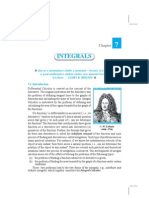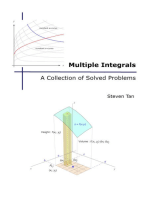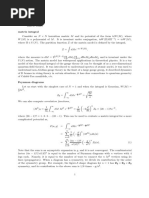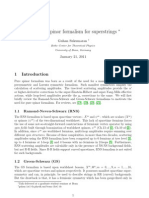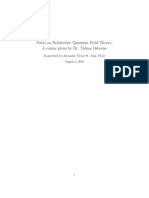8.325: Relativistic Quantum Field Theory III Problem Set 2
Uploaded by
belderandover098.325: Relativistic Quantum Field Theory III Problem Set 2
Uploaded by
belderandover098.
325: Relativistic Quantum Field Theory III
Problem Set 2
Due date: 18
th
February, 2014
1. (5 points) Eective action:
Consider the eective action, [
i
] = W[J
i
]
x
J
x,i
x,i
for a set of scalar elds
x,i
=
i
(x). The
are the
classical solutions in the presence of sources:
i
=
W
Ji
. Suppose the action and the functional integration
measure D =
i
D
i
are invariant under the transformation
i
(x)
i
(x) =
d
4
yR
ij
(x, y)
j
(y) (1)
for some function R
ij
(x, y).
(a) Show that the generating functional for connected diagrams is invariant under
J
i
(x) J
i
(x) =
d
4
yR
ij
(y, x)J
i
(y) (2)
(b) Show that the eective action is invariant under Eq. (1).
2. (15 points) Dyson-Schwinger equations:
Consider the real scalar
3
theory dened by the Lagrangian
L =
1
2
+ m
2
+
g
6
3
, (3)
and partition function and eective action
Z[J] = e
iW[J]
=
De
i(S+
R
x
Jxx)
, [ ] = W[J]
x
J
x
x
, (4)
where S =
x
L
x
is the action, J =
is an external source, and =
J
=
W
J
.
(a) Starting from the relation
D
exp[i(S+
J)] = 0, and making use of functional derivatives, construct
an equation that determines the propagator
xy
i
2
W
JxJy
J=0
(the connected two-point function) in
terms of itself and the one particle irreducible (1PI) three point function,
abc
3
a
b
c
=0
.
(b) Using an additional functional derivative, construct the Dyson-Schwinger equation that determine
abc
in
terms of itself, the propagator, and
abcd
4
a
b
c
d
=0
.
(c) From the Lagrangian, you know the tree level O(g
0
) two-point function,
(0)
xy
, and the tree level three-point
function is
(1)
abc
g where we are using the superscript to label the perturbative order in the coupling g to
which the Green function is accurate. Clearly the (n > 3)-point 1PI functions vanish at tree level and are
only generated at higher orders in the coupling. At what order is the leading perturbative contribution to
the 1PI n-point functions (draw a diagram)?
(d) Use the relations that you have found above to generate the perturbative expansion for the three-point
vertex up to O(g
5
). You can use the Dyson-Schwinger equations iteratively: using
(j)
ab...
on the RHS of the
equations, they determine
(j+1)
ab...
.
You might also like
- Worksheet-3 Relation and Function-FunctionsNo ratings yetWorksheet-3 Relation and Function-Functions21 pages
- " Analysis I", Exercise 7 Bachelor Applied Mathematics, Winter Term 2019/20No ratings yet" Analysis I", Exercise 7 Bachelor Applied Mathematics, Winter Term 2019/201 page
- Calc 3 Lecture Notes Section 12.4 1 of 7No ratings yetCalc 3 Lecture Notes Section 12.4 1 of 77 pages
- MATH 31B - Week 1 Exponential, Inverse Functions, and Logarithmic Functions (I)No ratings yetMATH 31B - Week 1 Exponential, Inverse Functions, and Logarithmic Functions (I)3 pages
- Spectral Element Approximation of Solutions of Functional Integral EquationsNo ratings yetSpectral Element Approximation of Solutions of Functional Integral Equations9 pages
- Applications of Dirac's Delta Function in Statistics: International Journal of Mathematical Education March 2004No ratings yetApplications of Dirac's Delta Function in Statistics: International Journal of Mathematical Education March 200413 pages
- (Texts in Applied Mathematics 12) J. Stoer, R. Bulirsch (Auth.) - Introduction To Numerical Analysis-Springer New York (1993) - 107-121No ratings yet(Texts in Applied Mathematics 12) J. Stoer, R. Bulirsch (Auth.) - Introduction To Numerical Analysis-Springer New York (1993) - 107-12115 pages
- C01 Calculus of One Variable - T1 - 1112No ratings yetC01 Calculus of One Variable - T1 - 111251 pages
- Solution of Legendre's and Bessel's Equations by Green's Function ApproachNo ratings yetSolution of Legendre's and Bessel's Equations by Green's Function Approach5 pages
- Sheet 8 Function and Inverse Trigonometry Function B PDFNo ratings yetSheet 8 Function and Inverse Trigonometry Function B PDF116 pages
- Hyperbolic Functions (Trigonometry) Mathematics E-Book For Public ExamsFrom EverandHyperbolic Functions (Trigonometry) Mathematics E-Book For Public ExamsNo ratings yet
- Get Statistical Field Theory for Neural Networks Moritz Helias free all chapters100% (3)Get Statistical Field Theory for Neural Networks Moritz Helias free all chapters41 pages
- Solution To Homework Set #5, Problem #1. Author: Jeff ShahinianNo ratings yetSolution To Homework Set #5, Problem #1. Author: Jeff Shahinian5 pages
- Arxiv - 0004125v1 - Ashok - Das - Topics in Finite Temperature Field TheoryNo ratings yetArxiv - 0004125v1 - Ashok - Das - Topics in Finite Temperature Field Theory38 pages
- PHYS 624 (Fall 2010) : Advanced Quantum Mechanics Homeworks 1 Homework 1 (Classical Field Theory), Due Wednes-Day, September 15No ratings yetPHYS 624 (Fall 2010) : Advanced Quantum Mechanics Homeworks 1 Homework 1 (Classical Field Theory), Due Wednes-Day, September 1524 pages
- Download Complete Quantum Field Theory A Diagrammatic Approach 1st Edition Ronald Kleiss PDF for All Chapters100% (3)Download Complete Quantum Field Theory A Diagrammatic Approach 1st Edition Ronald Kleiss PDF for All Chapters40 pages
- (Ebook) Problems in Quantum Field Theory: With Fully-Worked Solutions by Gelis, François ISBN 9781108838801, 1108838804 - Get the ebook in PDF format for a complete experienceNo ratings yet(Ebook) Problems in Quantum Field Theory: With Fully-Worked Solutions by Gelis, François ISBN 9781108838801, 1108838804 - Get the ebook in PDF format for a complete experience74 pages
- Phosphate Compounds of High and Low EnergyNo ratings yetPhosphate Compounds of High and Low Energy19 pages
- PHASM/G442 Particle Physics Dr. Ryan Nichol Prof. Ruben SaakyanNo ratings yetPHASM/G442 Particle Physics Dr. Ryan Nichol Prof. Ruben Saakyan35 pages
- Quantum Field Theory 2, Reprinted with corrections 2011 Edition Franz Mandl 2024 Scribd Download100% (4)Quantum Field Theory 2, Reprinted with corrections 2011 Edition Franz Mandl 2024 Scribd Download61 pages
- 10080-A First Book of Quantum Field Theory-Amitabha LahiriNo ratings yet10080-A First Book of Quantum Field Theory-Amitabha Lahiri393 pages
- Differential Renormalization of The Wess-Zumino ModelNo ratings yetDifferential Renormalization of The Wess-Zumino Model10 pages
- Ana-Maria Raclariu - Lectures On Celestial HolographyNo ratings yetAna-Maria Raclariu - Lectures On Celestial Holography36 pages
- Feynman Rules For Majorana-Neutrino Interactions - J. Gluza and M. Zrafek 1992No ratings yetFeynman Rules For Majorana-Neutrino Interactions - J. Gluza and M. Zrafek 19928 pages
- Notes On Relativistic Quantum Field Theory: A Course Given by Dr. Tobias OsborneNo ratings yetNotes On Relativistic Quantum Field Theory: A Course Given by Dr. Tobias Osborne97 pages
- Instant Download Quantum Field Theory: Feynman Path Integrals and Diagrammatic Techniques in Condensed Matter 1st Edition Lukong Cornelius Fai PDF All ChaptersNo ratings yetInstant Download Quantum Field Theory: Feynman Path Integrals and Diagrammatic Techniques in Condensed Matter 1st Edition Lukong Cornelius Fai PDF All Chapters55 pages
- An Introduction to Gauge Theories 1st Edition Nicola Cabibbo - Download the ebook now to never miss important information100% (3)An Introduction to Gauge Theories 1st Edition Nicola Cabibbo - Download the ebook now to never miss important information62 pages
- Post-Newtonian Corrections To The Motion of Spinning Bodies in NRGRNo ratings yetPost-Newtonian Corrections To The Motion of Spinning Bodies in NRGR18 pages
- Renormalization Theory and Effective Field Theory NeubertNo ratings yetRenormalization Theory and Effective Field Theory Neubert46 pages



















































